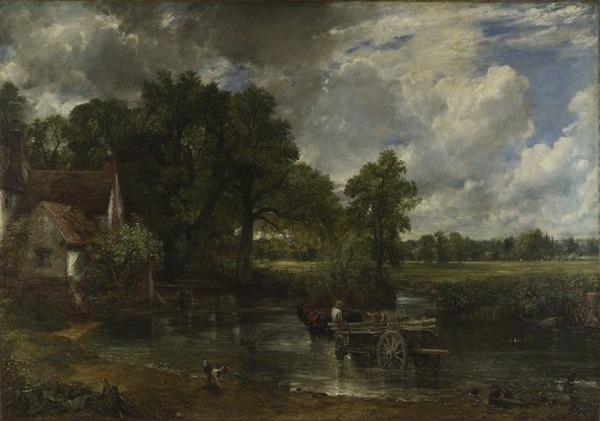The V&A is to mount a major autumn exhibition that will re-examine the work of John Constable (1776-1837). Constable, one of Britain’s best-loved artists was born in East Bergholt, Suffolk on 11 June 1776, he was the second son of a gentleman farmer and mill owner. Whilst working in the family business he became intimately familiar with the countryside around the River Stour and sketched observations of nature and the scenery and motifs of the Suffolk countryside. Given permission by his father to pursue art, he travelled to London in 1799 where he studied at the Royal Academy of Arts. He was schooled in the old masters, meticulously copying their work and reflecting on their compositions in his individual style. On display will be paintings including Moonlight Landscape (1635-1640) by Rubens and Landscape with a Pool (1746-7) by Gainsborough, which inspired Constable’s early practice.
The exhibition will highlight his sources, techniques and legacy and reveal the hidden stories behind the creation of some of his most well-known paintings.
Constable: The Making of a Master will juxtapose Constable’s work for the first time with the art of 17th-century masters of classical landscape such as Ruisdael, Rubens and Claude, whose compositional ideas and formal values Constable revered. On display will be such celebrated works as The Hay Wain (1821), The Cornfield (1826) and Salisbury Cathedral from the Meadows (1831), together with oil sketches Constable painted outdoors directly from nature, which are unequalled at capturing transient effects of light and atmosphere. The exhibition will bring together over 150 works of art including oil sketches, drawings, watercolours and engravings.
Martin Roth, V&A Director, said: “The V&A has been one of the leading centres for Constable research since the 19th century, following a significant gift of paintings, oil sketches and drawings from Constable’s daughter Isabel in 1888. This exhibition refreshes our understanding of his work and creative influence. It shows that Constable’s art, so well-loved and familiar to many of us, still delivers surprises.”
Constable made a number of close copies of the old masters which he referred to as a “facsimile…a more lasting remembrance.” Paintings including Claude’s Landscape with a Goatherd and Goats (c.1636-7) and Ruisdael’s Windmills near Haarlem (c.1650-52), as well as etchings and drawings by Herman van Swanevelt and Alexander Cozens, will be displayed alongside Constable’s own direct copies, many of which will be brought together for the first time since they were produced almost 200 years ago. Constable also owned an extensive art collection that included 5000 etchings principally by 17th-century Dutch, Flemish and French landscape painters, which became a vital resource for his own image making.
Outdoor sketching was central to Constable’s working method. The 1810s saw the beginning of a series of expressive oil sketches and drawings in the open air, capturing the changes of weather and light in his native countryside. His naturalistic representation of the landscape and use of broad brushstrokes and impasto technique challenged conventions and brought the genre of outdoor oil sketching to a new level of refinement. Examples of his cloud studies, including sketches of Hampstead Heath and Brighton Beach will demonstrate Constable’s innovative and poetic evocations of land, sea and sky.
The exhibition will also investigate Constable’s methods for transferring the freshness of his sketches into his exhibition paintings. From 1818-19 Constable produced full-scale oil sketches to resolve the compositions, colours and light values of his ‘six-footers’ such as The Hay Wain (1821) and The Leaping Horse (1825) which are amongst the best-known images in British art.
In the last decade of his life Constable and the engraver David Lucas collaborated on a series of mezzotints after the artist’s paintings. The final section of the exhibition will present a major group of these prints together with the exemplary original oil sketches on which they were based. Through these prints Constable sought to secure his artistic legacy and ensure the continued study of his groundbreaking paintings, which remain hugely influential to the present day.
Constable: The Making of a Master V&A 20 September 2014 – 11 January 2015

